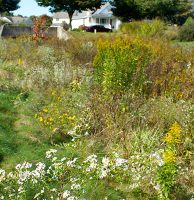
The Impact of Hyporheic Exchange on Stream Temperature in Restored Systems
LandStudies’ project along Kurtz Run in Lancaster County shows promise as an example of how floodplain restoration can result in improvement of hyporheic exchange within the system and how that improvement can benefit the health of the system.
Issue
One of the leading topics of discussion over the years in regard to stream health and water quality is stream temperature. It is commonly accepted that the best and most effective way to regulate stream temperature is by blocking incident solar radiation by shading with riparian vegetation. There is much evidence to support this practice and it is known that solar radiation is the primary contributor for thermal loading within a stream (Johnson 2004). Hyporheic exchange can provide additional benefits to riparian buffers, such as sustained temperature buffering, especially during the early stages of vegetative growth.
Background
In the context of overall stream health and stream temperature dynamics, the practice of enhancing surface-groundwater interaction, known as hyporheic exchange, in restored systems has shown real promise for sustainable water temperature regulation. Although the impact of hyporheic exchange has been shown to alter the mechanics of stream temperature regulation (Forney, Soulard, & Chickadel, 2013), its influence is rarely taken into account in temperature analyses.
Hyporheic exchange is best defined as the mixing of surface water and groundwater in the saturated region with and along a stream channel, also known as the hyporheic zone. This exchange is driven by energy gradients at and near the stream bed and banks and is impacted by characteristics such as channel bed topography, planform, and bed and bank material.
Case Study
To better understand the impact of hyporheic exchange on stream temperature, LandStudies compared a year of pre and post-restoration daily maximum temperatures for a floodplain restoration project completed in 2012 along Kurtz Run and its tributary in Lancaster County, PA.
The goals of this restoration were to effectively utilize multiple stormwater Best Management Practices (BMPs) to reduce stormwater runoff peaks and volumes below pre-development levels; to employ BMPs in a manner to provide water quality treatment for stormwater runoff prior to its entrance to surface waters; and increase stream channel stability and decrease bank erosion, further improving water quality.
The floodplain restoration project consisted of a number of physical modifications including floodplain grading/legacy sediment removal and channel relocation along both Kurtz Run and the unnamed tributary, the creation of over 300 ft of new stream channel, and the installation of in-stream structures such as root wads, log vanes, log sills, and toe wood protection. The project also included the creation of over 5 acres of wetland.
Findings
The results of the study indicate an improvement of hyporheic exchange within the system. Temperature data for 2011 and 2014 (representing pre and post-restoration conditions, respectively) was taken from five on site pressure transducers with integrated temperature probes, and solar radiation data was retrieved from a public NASA database. The daily maximum temperature was then plotted against total daily solar radiation to determine a relationship.
After analyzing the relationship between the two sets of data, preliminary results have indicated that the influence of solar radiation on stream temperature has been substantially reduced in the restored floodplain system.
Better understanding of the potential impact of hyporheic exchange on stream temperature could represent a significant opportunity to improve stream health with restoration practices that reconnect the stream channel with the hyporheic zone. LandStudies presented on this topic at the 2018 Susquehanna River Symposium at Bucknell University, and is in the process of completing a paper to be published further detailing the specifics of this analysis with additional supporting research, which will be made available upon completion.
References:
Forney, W. M., Soulard, C. E., & Chickadel, C. C. (2013). Salmonids, Stream Temperatures, and Solar Loading – Modeling the Shade Provided to the Klamath River by Vegetation and Geomorphology: U.S. Geological Survey Scientific Investigations Report 2013-5022. 25.
Johnson, S. L. (2004, July 24). Retrieved 6 21, 2016, from Oregon State University: http://forestry.oregonstate.edu/cof/fe/watershd/fe538/StreamTemperature/johnson_factors_effecting_stream_temp_CJOF04.pdf
Tonina, D., & Buffington, J. M. (2009). Hyporheic Exchange in Mountain Rvers I: Mechanics and Environmental Effects. Geography Compass , 1063-1086.


